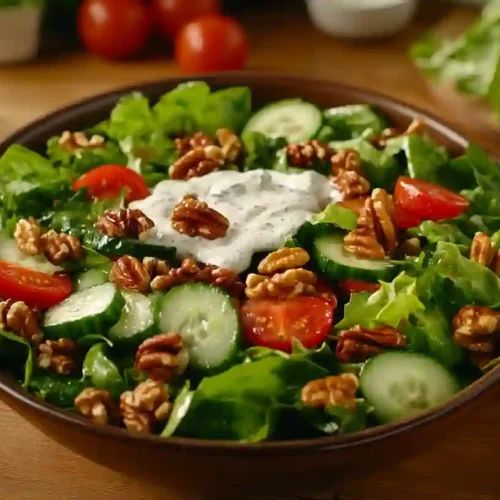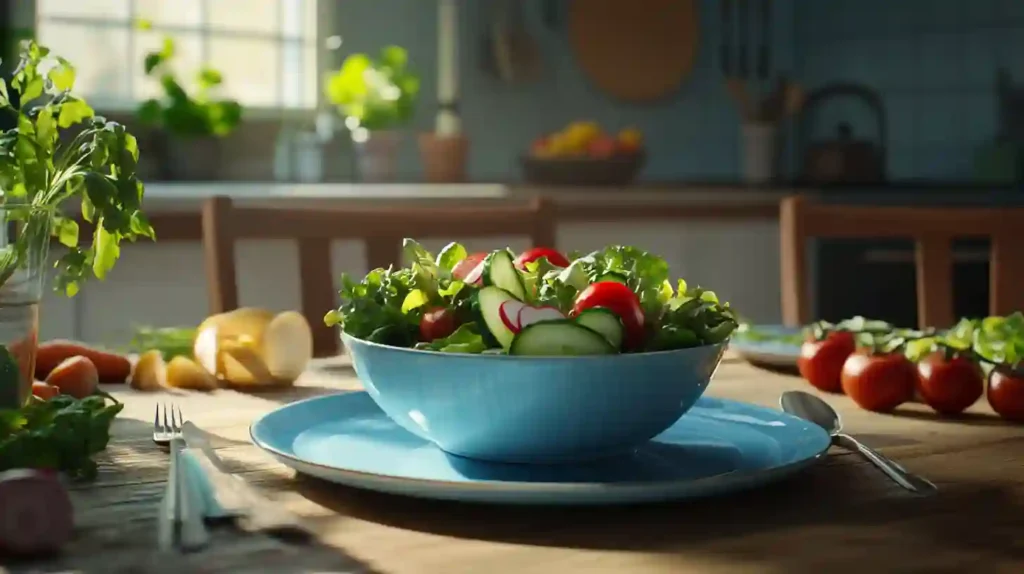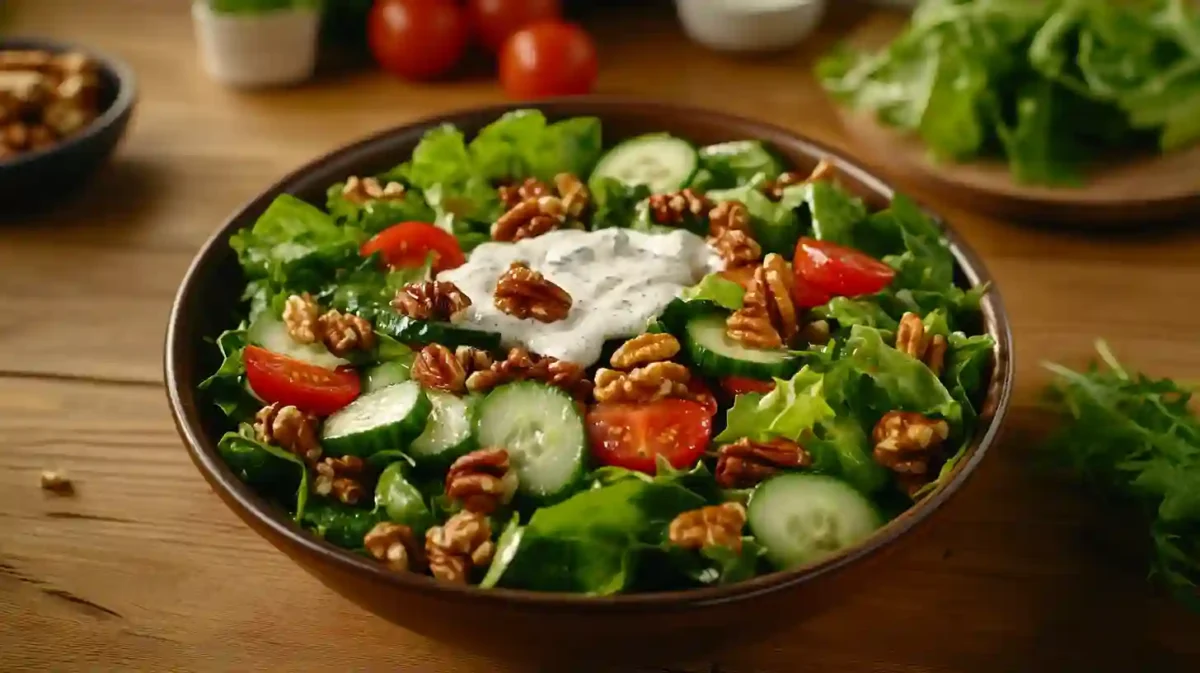When I think of classic vintage salads recipe , I can’t help but reminisce about family gatherings where these vibrant dishes took center stage. The history of salads is as rich and varied as the ingredients that go into them. Salads have been a staple in culinary traditions for centuries, dating back to ancient civilizations.

Classic Vintage Salad Recipe
Instructions
- "1 head romaine or iceberg lettuce", "1/2 cup cherry tomatoes", "1/4 cup sliced cucumbers", "1/4 cup sliced radishes", "1 apple, chopped", "1/4 cup walnuts", "1/4 cup mayonnaise or creamy dressing", "Salt and pepper to taste"
- HowToStep
- Wash and thoroughly dry all vegetables
Notes
Vintage Salad Recipe
Vintage Salad Recipe The Romans, for instance, enjoyed a variety of greens dressed with vinegar and oil, while the Greeks favored a mix of vegetables and herbs. These early iterations laid the groundwork for what we now consider vintage salads, which often feature a delightful combination of fresh produce, proteins, and dressings that evoke nostalgia. As I explored the evolution of salads, I discovered that the 19th and early 20th centuries were particularly influential in shaping the classic vintage salad we know today.
Vintage Salad Recipe This was a time when culinary creativity flourished, and salads became more than just a side dish; they transformed into elaborate presentations that showcased seasonal ingredients. I remember my grandmother’s famous ambrosia salad, a colorful mix of fruits and marshmallows that always made an appearance at holiday dinners. It’s fascinating to see how these recipes have stood the test of time, becoming cherished family traditions passed down through generations.
Key Takeaways
Classic vintage salads recipe have stood the test of time and continue to be a popular choice for a refreshing and flavorful dish.
The history of classic vintage salads dates back to the early 20th century, with recipes being passed down through generations.
To make a timeless vintage salad, gather fresh and high-quality ingredients, and follow traditional preparation methods for an authentic taste.
Add a modern twist to vintage salads by incorporating unique ingredients or presentation styles to appeal to contemporary palates.
Pair vintage salads with complementary dishes such as grilled meats, soups, or sandwiches to create a well-balanced and satisfying meal.
Ingredients and Preparation for a Timeless Salad
Creating a classic vintage salad recipe requires a thoughtful selection of ingredients that not only taste great but also evoke a sense of nostalgia. The foundation typically includes crisp greens like romaine or iceberg lettuce, which provide a refreshing crunch. I often find myself reaching for cherry tomatoes, cucumbers, and radishes to add vibrant colors and textures.
Vintage Salad Recipe One of my favorite combinations is a classic Waldorf salad, which features apples, celery, walnuts, and a creamy dressing. The balance of sweet and savory flavors is simply irresistible. Preparation is key to achieving that timeless quality in your salad.
Vintage Salad Recipe I’ve learned that taking the time to properly wash and chop your ingredients can make all the difference. For instance, when making a classic Caesar salad, I always ensure that my romaine is thoroughly dried after washing; soggy greens can ruin the entire experience. Additionally, I like to prepare my dressings from scratch whenever possible.
A homemade vinaigrette or creamy dressing not only enhances the flavor but also adds a personal touch that store-bought options simply can’t replicate.Vintage Salad Recipe

Tips for Serving a Vintage Salad with a Modern Twist
Serving a vintage salad doesn’t mean you have to stick strictly to tradition; there are plenty of ways to infuse modern flair into these classic recipes. One of my favorite tips is to incorporate unexpected ingredients that elevate the dish while still honoring its roots. For example, adding quinoa or farro can introduce a hearty element to a traditional green salad, making it more filling and nutritious. Vintage Salad Recipe
I once experimented with a classic Niçoise salad by adding roasted sweet potatoes, which provided a delightful sweetness that complemented the briny olives and anchovies. Presentation is another area where you can get creative. Instead of serving your salad in a standard bowl, consider using mason jars or elegant platters to showcase the vibrant colors of your ingredients. Vintage Salad Recipe
I remember hosting a brunch where I layered individual salads in jars, allowing guests to see all the beautiful components before they dug in. It not only made for an eye-catching display but also added an element of fun to the dining experience. Vintage Salad Recipe
Pairing Vintage Salads with Complementary Dishes
| Vintage Salad | Complementary Dish |
|---|---|
| Caesar Salad | Grilled Chicken |
| Cobb Salad | Grilled Steak |
| Greek Salad | Lamb Kebabs |
| Waldorf Salad | Roast Turkey |
Pairing vintage salads with complementary dishes can elevate your meal to new heights. When I think about my favorite combinations, I often recall summer barbecues where my aunt would serve her famous potato salad alongside her classic garden salad. The creamy texture of the potato salad perfectly balanced the crispness of the greens, creating a harmonious dining experience.
Similarly, pairing a classic Cobb salad with grilled chicken or fish can create a satisfying meal that feels both hearty and refreshing. Another delightful pairing I’ve enjoyed is serving a vintage pasta salad alongside grilled vegetables. The tangy dressing of the pasta salad complements the smoky flavors of the grilled veggies beautifully. Vintage Salad Recipe
I remember one summer evening when I hosted friends for dinner; we feasted on a colorful pasta salad filled with bell peppers and olives while savoring perfectly charred zucchini and eggplant. It was a simple yet elegant meal that showcased how well vintage salads can complement other dishes.
Common Mistakes To Avoid And their Solutions
As someone who has dabbled in various salad recipes over the years, I’ve encountered my fair share of mistakes along the way. One common pitfall is over-dressing the salad, which can lead to soggy greens and overpowering flavors. I learned this lesson the hard way during a dinner party when I drizzled too much dressing on my mixed greens.
The result was less than appetizing! Now, I always start with a small amount of dressing and toss gently, adding more as needed until I achieve the perfect balance. Another mistake is neglecting to season your ingredients properly. Vintage Salad Recipe
Fresh vegetables can be quite bland without a sprinkle of salt or pepper to enhance their natural flavors. I remember making a simple cucumber salad once and forgetting to season it adequately; it ended up tasting flat and uninspired. Now, I make it a point to taste as I go along, adjusting seasonings until everything sings harmoniously.
Variations and Adaptations of Traditional Vintage Salad Recipes
Experimenting with Ingredients
For instance, while preparing a classic Greek salad, I decided to swap out feta cheese for crumbled goat cheese one evening. The tangy flavor of the goat cheese added an unexpected twist that my guests raved about! It’s moments like these that remind me how versatile these recipes can be.
Transforming Classics
Another variation I love is transforming a classic tuna salad into a Mediterranean-inspired dish by incorporating chickpeas, olives, and sun-dried tomatoes. This adaptation not only adds depth but also introduces new textures and flavors that keep things exciting.
Playing with Dressings
I often find myself experimenting with different dressings as well; for example, using tahini instead of mayonnaise in my tuna salad has become one of my go-to modifications.
Preserving the Legacy of Vintage Salads in Today’s Culinary World
In today’s fast-paced culinary world, it’s easy for classic vintage salads to be overshadowed by trendy dishes and exotic ingredients. However, preserving these timeless recipes is essential for maintaining our culinary heritage. I often find myself sharing my family’s vintage salad recipes with friends who are eager to learn about traditional cooking methods.
It’s heartwarming to see their enthusiasm as they discover the joy of creating these beloved dishes from scratch. Moreover, social media has played an interesting role in keeping vintage salads alive. Platforms like Instagram allow food enthusiasts to showcase their takes on classic recipes while connecting with others who share their passion for cooking.
I’ve found inspiration from countless posts featuring beautifully arranged vintage salads that remind me of my childhood gatherings. By sharing our experiences and adaptations online, we contribute to the ongoing legacy of these cherished dishes in today’s culinary landscape.

FAQs
What is a classic vintage salad? A classic vintage salad refers to a traditional salad recipe that has stood the test of time and remains popular across generations. These salads often feature simple, fresh ingredients and timeless flavor combinations.
What is the history of classic vintage salads? Classic vintage salads have been a staple in culinary history, with many recipes dating back to the early 20th century. These salads were often created using seasonal and readily available ingredients, reflecting the resourcefulness and creativity of home cooks.
What are the ingredients and preparation for a timeless salad? Ingredients for a timeless salad typically include fresh greens, such as lettuce or spinach, along with a variety of vegetables, fruits, nuts, and a classic dressing, such as vinaigrette or mayonnaise-based. The preparation involves washing and chopping the ingredients, then tossing them together with the dressing just before serving.
What are some tips for serving a vintage salad with a modern twist? To give a vintage salad a modern twist, consider incorporating unique ingredients or flavor combinations, such as adding quinoa or using a trendy dressing. Additionally, presentation can be updated by arranging the salad in a creative and visually appealing manner.
How can vintage salads be paired with complementary dishes? Vintage salads can be paired with a variety of dishes, such as grilled meats, sandwiches, or soups. The key is to consider the flavors and textures of the salad and the accompanying dish to ensure they complement each other.
What are common mistakes to avoid when making vintage salads and their solutions? Common mistakes when making vintage salads include overdressing the salad, using wilted or low-quality ingredients, and not properly seasoning the salad. Solutions include using a light hand with the dressing, ensuring all ingredients are fresh, and tasting and adjusting the seasoning as needed.
What are some variations and adaptations of traditional vintage salad recipes? Variations of traditional vintage salad recipes can include adding different fruits, vegetables, or proteins, as well as experimenting with alternative dressings or garnishes. These adaptations can help breathe new life into classic recipes.
How can the legacy of vintage salads be preserved in today’s culinary world? The legacy of vintage salads can be preserved by continuing to share and celebrate these classic recipes, incorporating them into modern menus, and passing down the recipes and techniques to future generations. Additionally, chefs and home cooks can put their own spin on vintage salads to keep them relevant and appreciated.
